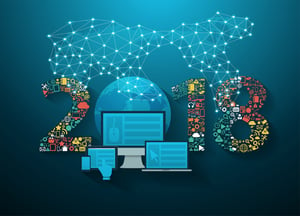 The marketing world is as fast-paced as ever thanks to continual technological changes and ever-expanding data access. Marketing teams are spending as much as one-third of their budgets on channels and features they had no idea about even a few years ago according to the State of Marketing report from Salesforce. The report found websites, social media, and email remain at the top of digital marketing trends for 2018, while “emerging” channels such as video advertising, mobile apps, SMS/text messaging, and sponsored content are close behind.
The marketing world is as fast-paced as ever thanks to continual technological changes and ever-expanding data access. Marketing teams are spending as much as one-third of their budgets on channels and features they had no idea about even a few years ago according to the State of Marketing report from Salesforce. The report found websites, social media, and email remain at the top of digital marketing trends for 2018, while “emerging” channels such as video advertising, mobile apps, SMS/text messaging, and sponsored content are close behind.
A “Consistent Experience”
Marketer competition has changed in recent years to focus on crafting unique and valuable customer experiences. These experiences are designed to remain consistent across all channels so consumers know that they can rely on certain brands and subsequently shift their loyalties. Brands that do not focus on the streamlined, personalized user experience increasingly see empty online shopping carts among other things. Consumers have the option to go with the brand that does offer the highly-customized experience they want, so why wouldn’t they?
Message & Data Evolution
The most successful brands create different user messages across different channels instead of implementing the same cookie-cutter message that consumer’s tire of quickly. This level of personalization requires serious data, something that marketers luckily have more access to. Consumers are more willing than ever to provide personal data so the brands they patronize provide them with the highly-customized shopping experiences they want. This includes how and when they shop, the best ways to reach them (such as by email or text message), and their overall interests and current lifestyle.
Typical data research includes demographics such as consumer age, occupation, gender, and income, where people live, and whether they are married or single. Psychographics play a role as well, such as asking customers about their motivation to purchase certain services or products, as well as their habits and hobbies. General and digital behavior round out brand data grabs, and include how often consumers purchase various products and use assorted channels. Digital behavior includes when and how often consumers answer emails, what links they click, when and why they abandon their shopping carts, and how they use social media. Acquiring this information translates into helping customers feel like they are being treated as people instead of numbers.
Consumer Experience Eclipsing Affordability
Today’s consumer is increasingly concerned with the brand experience, and is even willing to pay more for it. The idea of purchasing the more affordable product from a company offering little to no personalization may be over, as consumers patronize brands who go out of their way to show their customers they care. Brands that fail to deliver this customization lose to their competitors quickly.
Conclusion
Creating a more personalized user experience for your consumers offers a number of benefits, including customer loyalty and engagement, increased revenue, and improved customer satisfaction scores. Consumer willingness to recommend your products or services also improves. In short, you win from all sides.
Increase your brand’s awareness and personalize your customers’ experiences by working with Softline Solutions. We're always on top of the latest digital marketing trends.




